MaryAnn Bernal's Blog, page 99
May 23, 2016
History Trivia - Henry VIII marriage to Catherine of Aragon nullified
Published on May 23, 2016 01:30
May 22, 2016
Jawbone Jewelry: Archaeologists Discover 1,300-Year-Old Painted Bone Pendants in Mexico
Ancient Origins
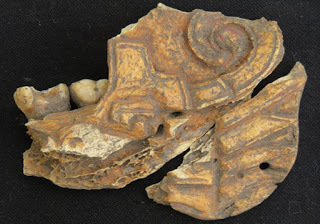 Archaeologists have unearthed painted human jawbones at a ceremonial site in Mexico associated with the ancient Zapotec civilization. It is believed the bones were worn as necklace pendants as part of their ancestor veneration rites. Dozens of whistles and statuettes, some honoring the Mesoamerican god Xipe Totec, were also found.
Archaeologists have unearthed painted human jawbones at a ceremonial site in Mexico associated with the ancient Zapotec civilization. It is believed the bones were worn as necklace pendants as part of their ancestor veneration rites. Dozens of whistles and statuettes, some honoring the Mesoamerican god Xipe Totec, were also found. Ceremonial Site of the ZapotecLive Science reports that the discovery was made at the ancient ceremonial site of Dainzú-Macuilxóchitl in the Oaxaca Valley in southern Mexico. Dainzú is a Zapotec archaeological site that was first occupied 700-600 BC, but the main phase of occupation dates from about 200 BC to 350 AD, and the latest discovery belongs to this period.
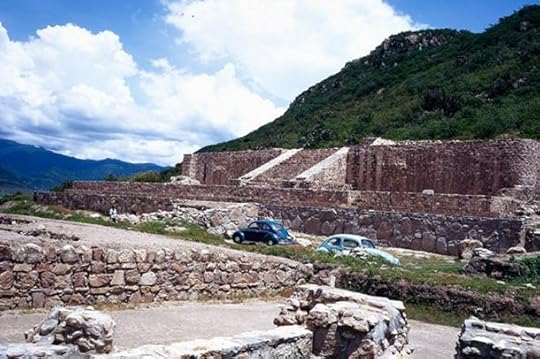 The archaeological site of Dainzú-Macuilxóchitl in the Oaxaca Valley in southern Mexico, once inhabited by the Zapotec civilization (
public domain
)The Zapotec civilization, or “Cloud People” as they are sometimes known, were an indigenous, pre-Columbian civilization that rose to power around 2,500 years ago. They left behind impressive ruins and provided a lasting influence on many of the cultures that superseded them.
The archaeological site of Dainzú-Macuilxóchitl in the Oaxaca Valley in southern Mexico, once inhabited by the Zapotec civilization (
public domain
)The Zapotec civilization, or “Cloud People” as they are sometimes known, were an indigenous, pre-Columbian civilization that rose to power around 2,500 years ago. They left behind impressive ruins and provided a lasting influence on many of the cultures that superseded them.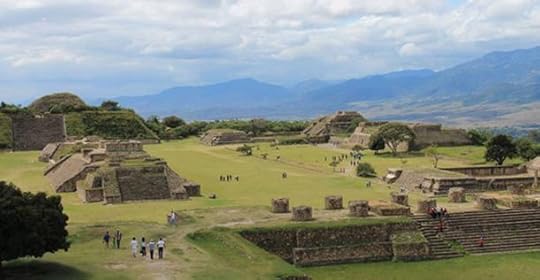 Panoramic of the Zapotec ruins of Monte Alban, Oaxaca, Mexico. (
public domain
)Painted BonesThe decorated jawbones were discovered in a ceremonial area of the Dainzú site, and while they were found alongside artifacts honouring the god Xipe Totec, who is associated with human sacrifice, the researchers do not believe the mandibles came from sacrifice victims.
Panoramic of the Zapotec ruins of Monte Alban, Oaxaca, Mexico. (
public domain
)Painted BonesThe decorated jawbones were discovered in a ceremonial area of the Dainzú site, and while they were found alongside artifacts honouring the god Xipe Totec, who is associated with human sacrifice, the researchers do not believe the mandibles came from sacrifice victims.According to Jeremias Pink, a graduate student at Oregon State University, who was involved with the finding, there is evidence that the Zapotec people exhumed, painted, and modified the bones of those buried in the residential complex.
People were "probably going into the tombs of their ancestors and bringing the remains of their ancestors out," Pink said [via Live Science]. People likely used the bones of their ancestors "in a ritual way to demonstrate the linkages between themselves and their ancestors as a way of sort of legitimizing their positions within that community," he said.
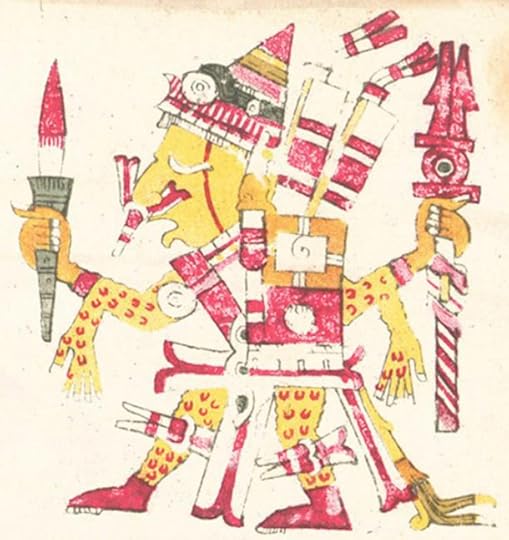 Xipe Totec as depicted in the Codex Borgia, shown holding a bloody weapon and wearing flayed human skin as a suit. (
public domain
)Amazing ArtifactsIn the same area that the jawbones were found, researchers also unearthed around 3,000 ceramic fragments of figurines, 30 figurine molds, and 1,600 whistle fragments. Some of the figurines depict Xipe Totec, while many others remain identified.
Xipe Totec as depicted in the Codex Borgia, shown holding a bloody weapon and wearing flayed human skin as a suit. (
public domain
)Amazing ArtifactsIn the same area that the jawbones were found, researchers also unearthed around 3,000 ceramic fragments of figurines, 30 figurine molds, and 1,600 whistle fragments. Some of the figurines depict Xipe Totec, while many others remain identified.Numerous Mesoamerican civilizations are known for their ornate and complex whistles, which were designed to emulate the sounds of animals, nature, and even human screams. The whistles themselves were often shaped like animals, humans or mythical beings.
The Lost Zapotec: Vibrant Mesoamerican Civilization of the Cloud PeopleThe Music of the Maya: Mysterious whistles Confound ExpertsAztec Death Whistles Sound like Human Screams and May Have Been Used as Psychological Warfare
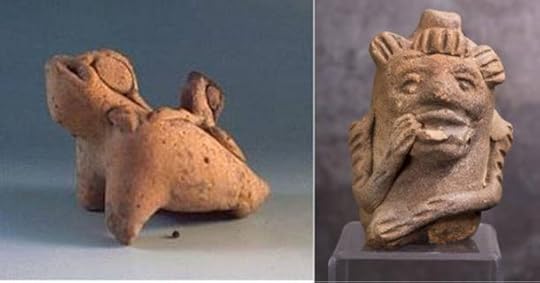 Left: A whistle in the shape of a frog from Yaxchilan (Tlapitzalli.com). Right: Maya monkey whistle. (William Scott / BigStockPhoto).The researchers speculate that the whistles and figurines had been intentionally smashed as part of their ceremonial rites, as evidence of this ritual has been found at numerous other Mesoamerican sites.
Left: A whistle in the shape of a frog from Yaxchilan (Tlapitzalli.com). Right: Maya monkey whistle. (William Scott / BigStockPhoto).The researchers speculate that the whistles and figurines had been intentionally smashed as part of their ceremonial rites, as evidence of this ritual has been found at numerous other Mesoamerican sites.Top image: Carved and painted human mandible (jawbone) was found in a ceremonial area within a residential complex at the site of Dainzú-Macuilxóchitl in Mexico. Credit: Erica Ausel (Ph.D. Indiana University)
By April Holloway
Published on May 22, 2016 03:00
History Trivia - Battle of the Granicus.
May 22
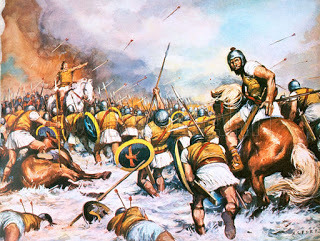
334 BC – The Macedonian army of Alexander the Great defeated Darius III of Persia in the Battle of the Granicus.

334 BC – The Macedonian army of Alexander the Great defeated Darius III of Persia in the Battle of the Granicus.
Published on May 22, 2016 01:30
May 21, 2016
7,000-Year-Old Forest and Footprints Uncovered in the Atlantis of Britain
Ancient Origins
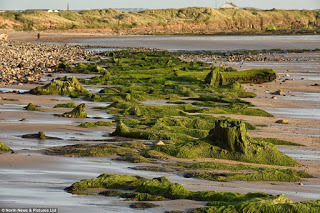
Ancient footprints as well as prehistoric tree stumps and logs have become visible along a 200-meter stretch of a coastline at Low Hauxley near Amble, Northumberland, in what is believed to be Doggerland, the Atlantis of Britain.
The Daily Mail reports that the forest existed in the late Mesolithic period. It began to form around 5,300 BC, and it was covered by the ocean three centuries later. The studies proved that at the time, when the ancient forest existed, the sea level was much lower. It was a period when Britain had recently separated from the land of what is currently Denmark. The forest consisted mostly of hazel, alder, and oak trees. Researchers believe the forest was part of Doggerland, an ancient stretch of a land, which connected the UK and Europe.
Doggerland: Stone Age Atlantis of BritainLocated in the North Sea, Doggerland is believed to have once measured approximately 100,000 square miles (258998 square kilometers). However, the end of the Ice Age saw a great rise in the sea level and an increase in storms and flooding in the region, causing Doggerland to gradually shrink.
Doggerland, sometimes called the Stone Age Atlantis of Britain or the prehistoric Garden of Eden, is an area archaeologists have been waiting to rediscover. Finally, modern technology has reached a level in which their dreams may become a reality. Doggerland is thought to have been first inhabited around 10,000 BC, and innovative technology is expected to aid a new study in glimpsing what life was like for the prehistoric humans living in the region before the catastrophic floods covered the territory sometime between 8000 - 6000 BC.
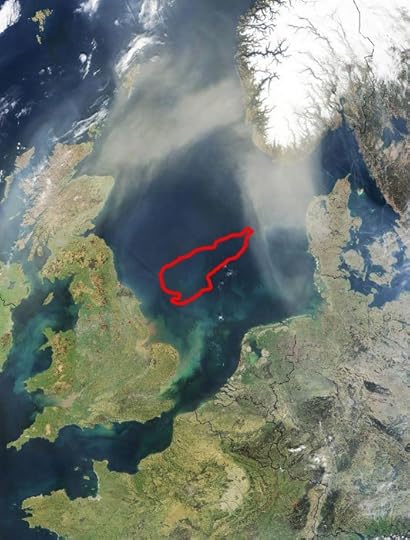 The area, which would have been home to a range of animals, as well as the hunter gatherers which stalked them, became flooded due to glacial melt, with some high-lying regions such as 'Dogger Island' (pictured right, highlighted red) serving as clues to the regions ancient past. (public domain)Sunken Land Reveals its SecretsThe latest research was made by a group of archeologists and volunteers led by a team from Archaeological Research Services Ltd, which previously performed some other projects related to the Northumberland. The works were possible due to the lower level of water. The major excavations involved a total of 700 people and uncovered part of an Iron Age site dating from around 300 BC near the Druidge Bay.
The area, which would have been home to a range of animals, as well as the hunter gatherers which stalked them, became flooded due to glacial melt, with some high-lying regions such as 'Dogger Island' (pictured right, highlighted red) serving as clues to the regions ancient past. (public domain)Sunken Land Reveals its SecretsThe latest research was made by a group of archeologists and volunteers led by a team from Archaeological Research Services Ltd, which previously performed some other projects related to the Northumberland. The works were possible due to the lower level of water. The major excavations involved a total of 700 people and uncovered part of an Iron Age site dating from around 300 BC near the Druidge Bay.
Doctor Clive Waddington, of Archaeology Research Services said:
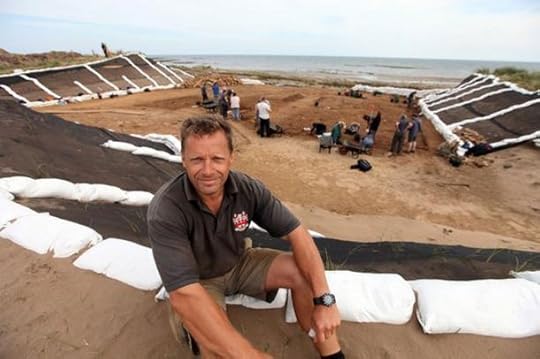 Clive Waddington, project director of Archaeological Research Services Ltd at the prehistoric archaeological dig at Low Hauxley near Amble, Northumberland (The Journal)Ancient FootprintsWaddington maintains that his team also discovered the evidence of humans living nearby. They found footprints of adults and children. Due to the results of the analysis of the footprints, it is believed that they wore leather shoes. Animal footprints of wild boar, brown bears and red deer also had been found.
Clive Waddington, project director of Archaeological Research Services Ltd at the prehistoric archaeological dig at Low Hauxley near Amble, Northumberland (The Journal)Ancient FootprintsWaddington maintains that his team also discovered the evidence of humans living nearby. They found footprints of adults and children. Due to the results of the analysis of the footprints, it is believed that they wore leather shoes. Animal footprints of wild boar, brown bears and red deer also had been found.
Fossilized ForestsThe remains of the forest of Doggerland do not belong to the oldest known forest. The oldest fossilized forest was discovered by a team from the Binghamton University in the town of Gilboa in upstate New York. The Gilboa area has been known as a tree fossil location since the late 19th century. However, the first researchers arrived there in the 1920s. The most recent research started in 2004, when Linda VanAller Hernick, paleontology collection manager, and Frank Mannolini, paleontology collection technician, uncovered more intact specimens. According to the article published in 2012 by William Stein, associate professor of biological sciences at Binghamton, the fossils discovered in this area are between 370 to 380 million years old.
See the 5,000-year-old forest unearthed by storms:
Featured image: The remains of an ancient forest in what is believed to have once formed part of Doggerland. Credit: North News and Pictures.
By Natalia Klimczak

Ancient footprints as well as prehistoric tree stumps and logs have become visible along a 200-meter stretch of a coastline at Low Hauxley near Amble, Northumberland, in what is believed to be Doggerland, the Atlantis of Britain.
The Daily Mail reports that the forest existed in the late Mesolithic period. It began to form around 5,300 BC, and it was covered by the ocean three centuries later. The studies proved that at the time, when the ancient forest existed, the sea level was much lower. It was a period when Britain had recently separated from the land of what is currently Denmark. The forest consisted mostly of hazel, alder, and oak trees. Researchers believe the forest was part of Doggerland, an ancient stretch of a land, which connected the UK and Europe.
Doggerland: Stone Age Atlantis of BritainLocated in the North Sea, Doggerland is believed to have once measured approximately 100,000 square miles (258998 square kilometers). However, the end of the Ice Age saw a great rise in the sea level and an increase in storms and flooding in the region, causing Doggerland to gradually shrink.
Doggerland, sometimes called the Stone Age Atlantis of Britain or the prehistoric Garden of Eden, is an area archaeologists have been waiting to rediscover. Finally, modern technology has reached a level in which their dreams may become a reality. Doggerland is thought to have been first inhabited around 10,000 BC, and innovative technology is expected to aid a new study in glimpsing what life was like for the prehistoric humans living in the region before the catastrophic floods covered the territory sometime between 8000 - 6000 BC.
 The area, which would have been home to a range of animals, as well as the hunter gatherers which stalked them, became flooded due to glacial melt, with some high-lying regions such as 'Dogger Island' (pictured right, highlighted red) serving as clues to the regions ancient past. (public domain)Sunken Land Reveals its SecretsThe latest research was made by a group of archeologists and volunteers led by a team from Archaeological Research Services Ltd, which previously performed some other projects related to the Northumberland. The works were possible due to the lower level of water. The major excavations involved a total of 700 people and uncovered part of an Iron Age site dating from around 300 BC near the Druidge Bay.
The area, which would have been home to a range of animals, as well as the hunter gatherers which stalked them, became flooded due to glacial melt, with some high-lying regions such as 'Dogger Island' (pictured right, highlighted red) serving as clues to the regions ancient past. (public domain)Sunken Land Reveals its SecretsThe latest research was made by a group of archeologists and volunteers led by a team from Archaeological Research Services Ltd, which previously performed some other projects related to the Northumberland. The works were possible due to the lower level of water. The major excavations involved a total of 700 people and uncovered part of an Iron Age site dating from around 300 BC near the Druidge Bay.Doctor Clive Waddington, of Archaeology Research Services said:
''In 5,000 BC the sea level rose quickly and it drowned the land. The sand dunes were blown back further into the land, burying the forest, and then the sea receded a little. The sea level is now rising again, cutting back the sand dunes, and uncovering the forest.''
 Clive Waddington, project director of Archaeological Research Services Ltd at the prehistoric archaeological dig at Low Hauxley near Amble, Northumberland (The Journal)Ancient FootprintsWaddington maintains that his team also discovered the evidence of humans living nearby. They found footprints of adults and children. Due to the results of the analysis of the footprints, it is believed that they wore leather shoes. Animal footprints of wild boar, brown bears and red deer also had been found.
Clive Waddington, project director of Archaeological Research Services Ltd at the prehistoric archaeological dig at Low Hauxley near Amble, Northumberland (The Journal)Ancient FootprintsWaddington maintains that his team also discovered the evidence of humans living nearby. They found footprints of adults and children. Due to the results of the analysis of the footprints, it is believed that they wore leather shoes. Animal footprints of wild boar, brown bears and red deer also had been found.Fossilized ForestsThe remains of the forest of Doggerland do not belong to the oldest known forest. The oldest fossilized forest was discovered by a team from the Binghamton University in the town of Gilboa in upstate New York. The Gilboa area has been known as a tree fossil location since the late 19th century. However, the first researchers arrived there in the 1920s. The most recent research started in 2004, when Linda VanAller Hernick, paleontology collection manager, and Frank Mannolini, paleontology collection technician, uncovered more intact specimens. According to the article published in 2012 by William Stein, associate professor of biological sciences at Binghamton, the fossils discovered in this area are between 370 to 380 million years old.
See the 5,000-year-old forest unearthed by storms:
Featured image: The remains of an ancient forest in what is believed to have once formed part of Doggerland. Credit: North News and Pictures.
By Natalia Klimczak
Published on May 21, 2016 03:00
History Trivia - Agonalia celebrated
May 21
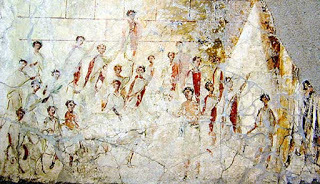
on this day The Agonalia was held. It was held on January 9th, March 17th, May 21st, and December 11th. On each day a ram was sacrificed, probably as an offering to Janus.

on this day The Agonalia was held. It was held on January 9th, March 17th, May 21st, and December 11th. On each day a ram was sacrificed, probably as an offering to Janus.
Published on May 21, 2016 02:00
May 20, 2016
1600-Year-Old Cargo of a Roman Merchant Ship has been Discovered in Caesarea
Ancient Origins
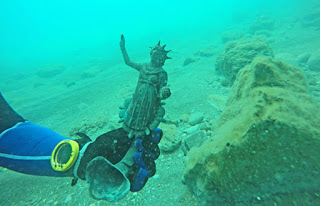
An underwater survey in the ancient port of Caesarea has uncovered thousands of coins and bronze statues dating to the 5th century AD.
The Greatest Catch Two sports divers likely made their greatest catch in life when they made a fortuitous discovery of two Late Roman bronze statues in the ancient port of Caesarea.
As soon as they had surfaced divers Ran Feinstein and Ofer Ra‘anan
reported the finds to the Israel Antiquities Authority. During a joint dive, Ran and Ofer, guided marine archaeologists from the IIA to the location.
The seabead had been cleared of sand and a maze of iron anchors, moorings chains and debris were left exposed, being the remains of a ship.
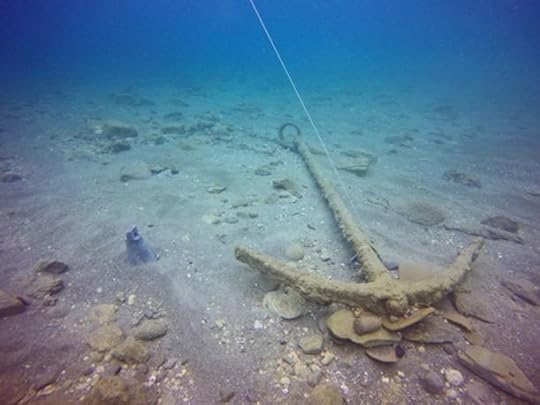 The ship’s anchor as it was discovered in the sea. Photographic credit: The Marine Archaeology Unit of the Israel Antiquities Authority. During the next weeks the IIA conducted an underwater salvage survey and in a relatively short time, they had recovered beautiful bronze statues, thousands of coins and other finds on the seabed dating to 5th century AD.
The ship’s anchor as it was discovered in the sea. Photographic credit: The Marine Archaeology Unit of the Israel Antiquities Authority. During the next weeks the IIA conducted an underwater salvage survey and in a relatively short time, they had recovered beautiful bronze statues, thousands of coins and other finds on the seabed dating to 5th century AD.
The treasure throw belonged to a Late Roman Merchant ships that sank in the harbor some 1600 years ago.
Wrecked by a Storm Many of the artifacts are bronze and in an extraordinary state of preservation: a bronze lamp depicting the image of the sun god Sol, a figurine of the moon goddess Luna, a lamp in the image of the head of an African slave, fragments of three life-size bronze cast statues, objects fashioned in the shape of animals such as a whale, a bronze faucet in the form of a wild boar with a swan on its head.
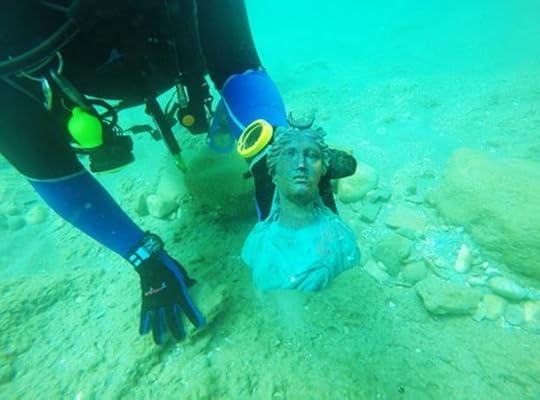 Fragment of a bronze lamp decorated with the image of the sun god Luna, as discovered on the seabed. Photo: Ran Feinstein.
Fragment of a bronze lamp decorated with the image of the sun god Luna, as discovered on the seabed. Photo: Ran Feinstein. 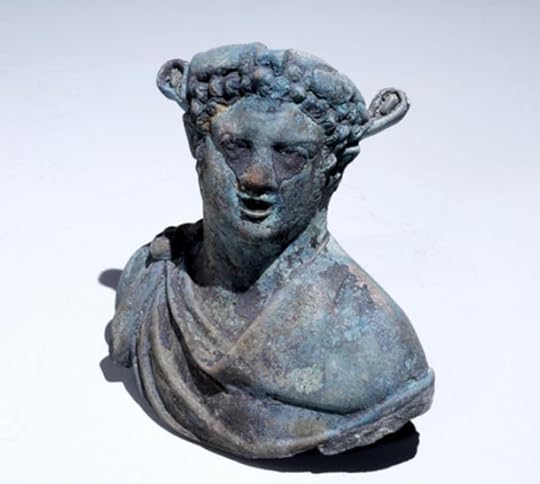 A lamp in the image of the head of an African slave. Photographic credit: Clara Amit, courtesy of the Israel Antiquities Authority.
A lamp in the image of the head of an African slave. Photographic credit: Clara Amit, courtesy of the Israel Antiquities Authority. 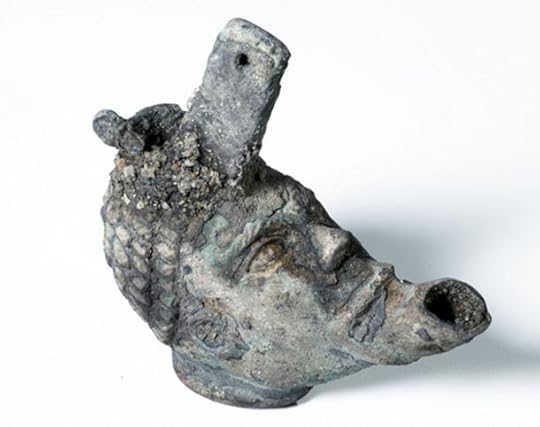 Fragment of a life-size head of a statue. Photographic credit: Clara Amit, courtesy of the Israel Antiquities Authority. In addition, fragments of large jars were found that were used for carrying drinking water for the crew in the ship and for transportation at sea. One of the biggest surprises in particular was the discovery of two metallic lumps composed of thousands of coins weighing c. 20 kilograms which was in the form of the pottery vessel in which they were transported.
Fragment of a life-size head of a statue. Photographic credit: Clara Amit, courtesy of the Israel Antiquities Authority. In addition, fragments of large jars were found that were used for carrying drinking water for the crew in the ship and for transportation at sea. One of the biggest surprises in particular was the discovery of two metallic lumps composed of thousands of coins weighing c. 20 kilograms which was in the form of the pottery vessel in which they were transported.
“These are extremely exciting finds, which apart from their extraordinary beauty, are of historical significance. The location and distribution of the ancient finds on the seabed indicate that a large merchant ship was carrying a cargo of metal slated recycling, which apparently encountered a storm at the entrance to the harbor and drifted until it smashed into the seawall and the rocks”, said Jacob Sharvit, director of the Marine Archaeology Unit of the IIA, and adds,
“A marine assemblage such as this has not been found in Israel in the past thirty years. Metal statues are rare archaeological finds because they were always melted down and recycled in antiquity. When we find bronze artifacts it usually occurs at sea. Because these statues were wrecked together with the ship, they sank in the water and were thus ‘saved’ from the recycling process”.
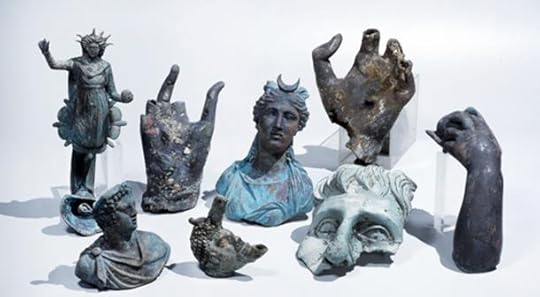 The rare bronze artifacts that were discovered in Caesarea. Photographic credit: Clara Amit, courtesy of the Israel Antiquities Authority. Coins carrying the Image of Constantine The coins that were discovered bear the image of the emperor Constantine who ruled the Western Roman Empire (312–324 AD) and was later known as Constantine the Great, ruler of the Roman Empire (324–337 AD), and of Licinius, an emperor who ruled the eastern part of the Roman Empire and was a rival of Constantine, until his downfall in a battle that was waged between the two rulers.
The rare bronze artifacts that were discovered in Caesarea. Photographic credit: Clara Amit, courtesy of the Israel Antiquities Authority. Coins carrying the Image of Constantine The coins that were discovered bear the image of the emperor Constantine who ruled the Western Roman Empire (312–324 AD) and was later known as Constantine the Great, ruler of the Roman Empire (324–337 AD), and of Licinius, an emperor who ruled the eastern part of the Roman Empire and was a rival of Constantine, until his downfall in a battle that was waged between the two rulers.
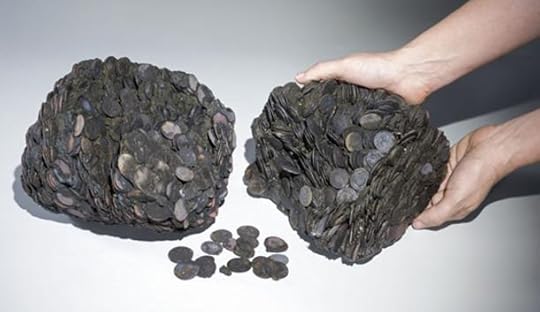 Lumps of coins that were discovered at sea, weighing a total of c. 20 kilograms. Photographic credit: Clara Amit, courtesy of the Israel Antiquities Authority. The range of finds recovered from the sea reflects the large volume of trade and the status of Caesarea’s harbor during this time, which was known as period of economic and commercial stability in the wake of the stability of the Roman Empire- the period when Christianity was on its way to becoming the official religion of the Roman Empire.
Lumps of coins that were discovered at sea, weighing a total of c. 20 kilograms. Photographic credit: Clara Amit, courtesy of the Israel Antiquities Authority. The range of finds recovered from the sea reflects the large volume of trade and the status of Caesarea’s harbor during this time, which was known as period of economic and commercial stability in the wake of the stability of the Roman Empire- the period when Christianity was on its way to becoming the official religion of the Roman Empire.
It was at this time that Emperor Constantine put a halt to the policy of persecuting Christians, and the faithful in Caesarea, as well as elsewhere in the Roman Empire, were given the legitimacy to practice their belief through the famous Edict of Milan that proclaimed Christianity was no longer a banned religion. Later, Constantine recognized Christianity as the official state religion, and it was during his reign that the fundamentals of the religion were established.
While the new finds are being studied by the IIA, a cache of gold coins that was discovered water off of Caesarea in the winter of 2015 are already being displayed to the visiting public in the Caesarea harbor.
By Sam Bostrom
Featured image: A figurine of the sun god Sol as discovered on the seabed. Photo: Ran Feinstein.

An underwater survey in the ancient port of Caesarea has uncovered thousands of coins and bronze statues dating to the 5th century AD.
The Greatest Catch Two sports divers likely made their greatest catch in life when they made a fortuitous discovery of two Late Roman bronze statues in the ancient port of Caesarea.
As soon as they had surfaced divers Ran Feinstein and Ofer Ra‘anan
reported the finds to the Israel Antiquities Authority. During a joint dive, Ran and Ofer, guided marine archaeologists from the IIA to the location.
The seabead had been cleared of sand and a maze of iron anchors, moorings chains and debris were left exposed, being the remains of a ship.
 The ship’s anchor as it was discovered in the sea. Photographic credit: The Marine Archaeology Unit of the Israel Antiquities Authority. During the next weeks the IIA conducted an underwater salvage survey and in a relatively short time, they had recovered beautiful bronze statues, thousands of coins and other finds on the seabed dating to 5th century AD.
The ship’s anchor as it was discovered in the sea. Photographic credit: The Marine Archaeology Unit of the Israel Antiquities Authority. During the next weeks the IIA conducted an underwater salvage survey and in a relatively short time, they had recovered beautiful bronze statues, thousands of coins and other finds on the seabed dating to 5th century AD. The treasure throw belonged to a Late Roman Merchant ships that sank in the harbor some 1600 years ago.
Wrecked by a Storm Many of the artifacts are bronze and in an extraordinary state of preservation: a bronze lamp depicting the image of the sun god Sol, a figurine of the moon goddess Luna, a lamp in the image of the head of an African slave, fragments of three life-size bronze cast statues, objects fashioned in the shape of animals such as a whale, a bronze faucet in the form of a wild boar with a swan on its head.
 Fragment of a bronze lamp decorated with the image of the sun god Luna, as discovered on the seabed. Photo: Ran Feinstein.
Fragment of a bronze lamp decorated with the image of the sun god Luna, as discovered on the seabed. Photo: Ran Feinstein.  A lamp in the image of the head of an African slave. Photographic credit: Clara Amit, courtesy of the Israel Antiquities Authority.
A lamp in the image of the head of an African slave. Photographic credit: Clara Amit, courtesy of the Israel Antiquities Authority.  Fragment of a life-size head of a statue. Photographic credit: Clara Amit, courtesy of the Israel Antiquities Authority. In addition, fragments of large jars were found that were used for carrying drinking water for the crew in the ship and for transportation at sea. One of the biggest surprises in particular was the discovery of two metallic lumps composed of thousands of coins weighing c. 20 kilograms which was in the form of the pottery vessel in which they were transported.
Fragment of a life-size head of a statue. Photographic credit: Clara Amit, courtesy of the Israel Antiquities Authority. In addition, fragments of large jars were found that were used for carrying drinking water for the crew in the ship and for transportation at sea. One of the biggest surprises in particular was the discovery of two metallic lumps composed of thousands of coins weighing c. 20 kilograms which was in the form of the pottery vessel in which they were transported. “These are extremely exciting finds, which apart from their extraordinary beauty, are of historical significance. The location and distribution of the ancient finds on the seabed indicate that a large merchant ship was carrying a cargo of metal slated recycling, which apparently encountered a storm at the entrance to the harbor and drifted until it smashed into the seawall and the rocks”, said Jacob Sharvit, director of the Marine Archaeology Unit of the IIA, and adds,
“A marine assemblage such as this has not been found in Israel in the past thirty years. Metal statues are rare archaeological finds because they were always melted down and recycled in antiquity. When we find bronze artifacts it usually occurs at sea. Because these statues were wrecked together with the ship, they sank in the water and were thus ‘saved’ from the recycling process”.
 The rare bronze artifacts that were discovered in Caesarea. Photographic credit: Clara Amit, courtesy of the Israel Antiquities Authority. Coins carrying the Image of Constantine The coins that were discovered bear the image of the emperor Constantine who ruled the Western Roman Empire (312–324 AD) and was later known as Constantine the Great, ruler of the Roman Empire (324–337 AD), and of Licinius, an emperor who ruled the eastern part of the Roman Empire and was a rival of Constantine, until his downfall in a battle that was waged between the two rulers.
The rare bronze artifacts that were discovered in Caesarea. Photographic credit: Clara Amit, courtesy of the Israel Antiquities Authority. Coins carrying the Image of Constantine The coins that were discovered bear the image of the emperor Constantine who ruled the Western Roman Empire (312–324 AD) and was later known as Constantine the Great, ruler of the Roman Empire (324–337 AD), and of Licinius, an emperor who ruled the eastern part of the Roman Empire and was a rival of Constantine, until his downfall in a battle that was waged between the two rulers.  Lumps of coins that were discovered at sea, weighing a total of c. 20 kilograms. Photographic credit: Clara Amit, courtesy of the Israel Antiquities Authority. The range of finds recovered from the sea reflects the large volume of trade and the status of Caesarea’s harbor during this time, which was known as period of economic and commercial stability in the wake of the stability of the Roman Empire- the period when Christianity was on its way to becoming the official religion of the Roman Empire.
Lumps of coins that were discovered at sea, weighing a total of c. 20 kilograms. Photographic credit: Clara Amit, courtesy of the Israel Antiquities Authority. The range of finds recovered from the sea reflects the large volume of trade and the status of Caesarea’s harbor during this time, which was known as period of economic and commercial stability in the wake of the stability of the Roman Empire- the period when Christianity was on its way to becoming the official religion of the Roman Empire. It was at this time that Emperor Constantine put a halt to the policy of persecuting Christians, and the faithful in Caesarea, as well as elsewhere in the Roman Empire, were given the legitimacy to practice their belief through the famous Edict of Milan that proclaimed Christianity was no longer a banned religion. Later, Constantine recognized Christianity as the official state religion, and it was during his reign that the fundamentals of the religion were established.
While the new finds are being studied by the IIA, a cache of gold coins that was discovered water off of Caesarea in the winter of 2015 are already being displayed to the visiting public in the Caesarea harbor.
By Sam Bostrom
Featured image: A figurine of the sun god Sol as discovered on the seabed. Photo: Ran Feinstein.
Published on May 20, 2016 03:00
History Trivia - Battle of Dunnichen
May 20
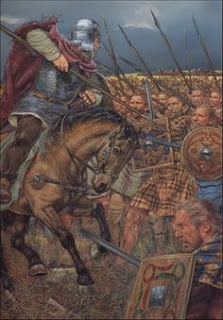
685 The Battle of Dunnichen or Nechtansmere was fought between a Pictish army under King Bridei III and the invading Northumbrians under King Ecgfrith, who were decisively defeated. 1217

685 The Battle of Dunnichen or Nechtansmere was fought between a Pictish army under King Bridei III and the invading Northumbrians under King Ecgfrith, who were decisively defeated. 1217
Published on May 20, 2016 02:00
May 19, 2016
9 of history's best quotes
History Extra
 Queen Victoria, who reportedly said "We are not amused". (Hulton Archive/Getty Images)
Queen Victoria, who reportedly said "We are not amused". (Hulton Archive/Getty Images)
Neil Armstrong: “That’s one small step for man, one giant leap for mankind” On 20 July 1969, as Neil Armstrong became the first man to set foot on the moon, he marked the momentous event with this iconic statement. After jumping more than three feet down from his spacecraft Apollo 11 onto the moon’s surface and issuing his immortal words, Armstrong explored the moon’s surface for two-and-a-half hours along with fellow American astronaut Edwin ‘Buzz’ Aldrin. The pair made their mark by planting an American flag and a plaque that read, "Here men from the planet Earth first set foot upon the moon. July 1969 A.D. We came in peace for all mankind". Interestingly, though, the words uttered by Armstrong in that historic moment are in fact a misquote. After a safe journey home Armstrong told the press that what he had actually said – or intended to – was, “That’s one small step for a man”. The indefinite article was lost over the crackling audio connection – a small omission that led to a significant change in the quote’s meaning. Armstrong acknowledged this, saying that “The ‘a’ was intended. I thought I said it”. Yet since the misquote had already been repeated the world over, Armstrong was forced to concede “I can’t hear it when I listen on the radio reception here on earth, so I’ll be happy if you just put it in parentheses”.
American astronaut Neil Armstrong, the first man to walk on the moon as commander of the Apollo 11 lunar mission. (MPI/Getty Images) Marie Antoinette: “Let them eat cake!” According to popular legend, this flippant remark was Marie Antoinette’s response to being told that the French people were starving and they could not afford bread. The quote, widely attributed to her, has become a symbol of the callous decadence of France’s monarchy on the eve of the French Revolution (1789–99). Antoinette was famed for her extravagant lifestyle, and her exclamation of “Qu'ils mangent de la brioche" (which actually translates more literally to ‘let them eat brioche’ or a enriched, egg-based bread) was seen as damning mockery of the plight of her people. It is now generally accepted, though, that Antoinette most likely never uttered these famous words. Instead they are thought to have been attributed to her by revolutionary propaganda keen to portray her as ignorant, distant and uncaring. Writing for History Revealed magazine, Emily Brand has suggested that the expression in fact pre-dates Antoinette. It is first referenced as the words “of a great princess” in Jean-Jacques Rousseau’s 1766 treatise Confessions, written when Antoinette was only 11 years old. Brand argues the saying was only linked to Antoinette 50 years after her execution in 1793. But while this quote may not in reality have been uttered by Antoinette, the phrase had sticking power because of the popular perception, whether justified or not, of the French queen as outrageously extravagant and insensitive to the struggles of her people.
Marie Antoinette in a 1775 portrait by Jean-Baptiste Gautier Dagoty. (Universal History Archive/Getty Images)
Winston Churchill: “We shall fight on the beaches… we shall never surrender” Over the course of his political career, Winston Churchill delivered many iconic speeches in the face of war and hardship. From “Never in the field of human conflict was so much owed by so many to so few” (1940) to “An iron curtain has descended across the continent” (1946), Churchill has been recognised as one of history’s most inspiring speakers. Churchill’s “We shall fight on the beaches” quote was part of a grave yet rousing speech given by the prime minister in the aftermath the 1940 Dunkirk evacuation. Churchill’s words were arguably fundamental in transforming the event in the popular imagination from a humiliating defeat into a miraculous triumph of bravery and determination. Indeed, Churchill’s words – which are often misquoted as “we shall fight them on the beaches” – have been immortalised as an example of Britain’s plucky ‘Blitz spirit’ in the face of adversity. A frequently misremembered fact about the “We shall fight on the beaches” speech is that Churchill did not originally read it out over the nation’s airwaves. He delivered the speech unrecorded to the House of Commons and sections of it were later read out by a BBC radio announcer. The famous recording we recognise today was not actually made until nine years later in 1949, when it was thought that Churchill's words should be set down for posterity.
Churchill delivering his “I have nothing to offer but blood, toil, tears and sweat” speech over BBC radio in 1940. (Keystone-France/Gamma-Keystone via Getty Images) Queen Victoria: “We are not amused” The story goes that this famous line was Queen Victoria’s retort to a risqué anecdote told by a tactless guest at a Windsor dinner party. In this version of events the “we” is intended, not as the royal “we”, but as a reference to all the ladies present who were unimpressed by such vulgar behaviour. Disappointingly, though, it is not clear whether this story stems from historical fact or just appealing urban legend. “We are not amused” has perhaps had such sticking power because it is emblematic of the public image of Victoria in her later years – a po-faced, dumpy woman dressed in black. The quote fits neatly with this straitlaced portrayal of her and also provides a handy epithet for popular ideas about Victorian society being stuffy and uptight. The association of Victoria with the humourless quote arguably portrays the monarch in an unfair light. Writing for the Washington Post, historian Kate Williams has suggested that “dour” photos of Victoria, (the first photographed monarch) – taken before people learned how to pose – “unfairly colour our view of her”. Williams claims that Victoria was “full of passion for life, forgiving of moral peccadilloes” and “always loved laughter and jokes”. She was, in fact, often amused.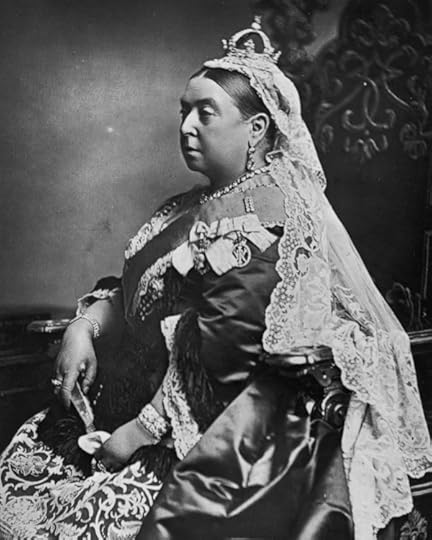
A photograph of Queen Victoria c1887. (Alexander Bassano/Spencer Arnold/Getty Images) Julius Caesar: “I came, I saw, I conquered” Translated from the Latin “Veni, Vidi, Vici”, this line is attributed to Roman emperor Julius Caesar, who supposedly used it to boast of his military success. According to ancient accounts, Caesar sent the three-word message to Rome in 47 BC to report on his victory over Pharnaces II of Pontus in the battle of Zela. Despite being significantly outnumbered at Zela, Caesar managed to crush the Pontic forces. His five-day campaign proved a swift, decisive victory that saw Pharnaces subdued by Caesar’s military might. According to Roman historian Suetonius’s The Twelve Caesars (AD 121) the “Veni, Vidi, Vici” slogan was also inscribed on placards during the ‘Pontic triumph’ – a public procession in celebration of Caesar’s return to Rome following his military victory. In his Life of Caesar, Greek biographer Plutarch (c46–120 AD) writes that “In Latin the words have the same inflectional ending, and so a brevity which is most impressive”.
Bust of Julius Caesar. (National Museum in Naples/Bettman/Getty) FDR: “The only thing we have to fear is fear itself” These famous words were spoken during Franklin D Roosevelt’s first inaugural address, delivered at the United States Capitol, Washington DC on 4 March 1933. Following an election victory over republican Herbert Hoover in 1932, Roosevelt became the 32nd president of the United States. Known as ‘FDR’, he went on to become the first president to serve a total of four terms. Elected during the depths of America’s Great Depression, Roosevelt made his 20-minute address a solemn and resolved affair. It tackled head-on the nation’s economic crisis and unemployment, blaming the “callous and selfish wrongdoing” of bankers and businessmen. This quote, which goes on to describe “fear itself” as the “nameless, unreasoning, unjustified terror which paralyses needed effort to convert retreat into advance” appeared near the very beginning of Roosevelt’s address. Contemporaries understood it as a pointed attack on the damaged and pessimistic American mindset of the time, which had been dealt a heavy blow by the economic crash. Broadcast to tens of millions of Americans over national radio networks, FDR’s speech was generally accepted as a dynamic and inspiring promise to get America back on track.
President Franklin D. Roosevelt delivers his first inaugural address at the Capitol in 1933. (George Rinhart/Corbis via Getty Images) Oscar Wilde: “There is only one thing in life worse than being talked about, and that is not being talked about” This remark, from Oscar Wilde’s 1890 novel The Picture of Dorian Gray, is just one example of reams of quotable material from the celebrated writer, conversationalist and wit. Wilde’s comic plays made a satire of the contradictions and petty manners of polite Victorian society. Works including The Importance of Being Earnest (1895) and An Ideal Husband (1895) are full of the wry observances and witty aphorisms for which Wilde is best known. Dozens of his phrases, including “We are all in the gutter, but some of us are looking at the stars”; “Always forgive your enemies – nothing annoys them so much” and “I have nothing to declare but my genius” have proven enduringly popular. In 2007 Wilde was voted Britain’s greatest wit in a poll of more than 3,000 comedy fans, beating to the top spot Spike Milligan, Winston Churchill and Noel Coward. The Irish-born Wilde was wisecracking until the very end, reportedly quipping on his Parisian deathbed in November 1900, “Either those curtains go, or I do”.
Colourised photograph of Oscar Wilde from around 1870. (Roger Viollet Collection/Getty Images) Queen Elizabeth I: “I know I have the body of a weak and feeble woman, but I have the heart and stomach of a king, and of a king of England too” This assertion of royal power from Elizabeth I was part of a rousing speech delivered by the queen in one of England’s darkest moments, as the nation faced the threat of imminent attack from the Spanish Armada. Elizabeth’s rallying cry was intended to motivate the English troops assembled at Tilbury in August 1588 as they awaited the arrival of an unprecedented Spanish invasion force. Through her words the queen clearly portrayed herself as a warrior ready to fight for her nation. Accounts portray Elizabeth addressing her troops atop a white steed, wearing a helmet and cutlass. Despite the threat to her safety, the queen allegedly refused to return to London, instead resolving to stay at the English army camp at Tilbury. She reportedly declared that she would “not think of deserting her army at a time of danger”. Writing for History Extra in 2015, Robert Hutchinson revealed that although the speech elsewhere pledges that “shortly we shall have a famous victory over these enemies of my God, of my kingdom, and of my people’’, in reality it was probably not delivered in a moment of imminent danger. Hutchinson suggests that Elizabeth’s stirring words only reached her men after the Armada was already in retreat. The words were recorded by royal courtier Lionel Sharp and later repeated to the army.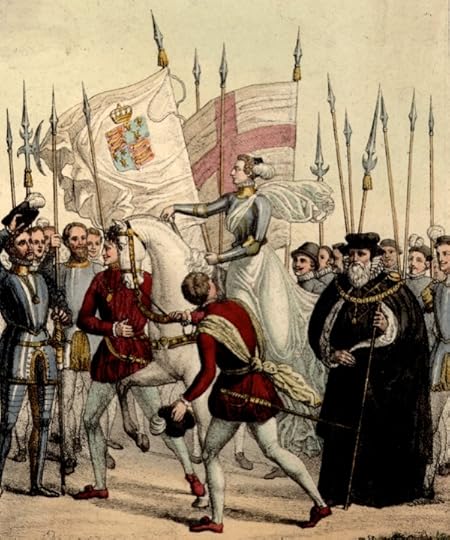
Elizabeth I of England is depicted riding a horse as she reviews her troops at Tilbury, c1560. (Hulton Archive/Getty Images) Eleanor Roosevelt: “Women are like teabags – you don’t know how strong they are until you put them in hot water” While her husband, Franklin D Roosevelt, was serving as US president between 1933 and 1945, Eleanor Roosevelt redefined the role of first lady through her active engagement in politics. An outspoken social campaigner and early ambassador of the United Nations, Eleanor was also engaged in human rights work, playing a significant role in the Universal Declaration of Human Rights in 1948. Many inspirational quotes have been attributed to Eleanor, including “No one can make you feel inferior without your consent”; “Do one thing every day that scares you” and “It is not fair to ask of others what you are not willing to do yourself”. Her “Women are like teabags” quote seems to draw on several older variations of the idea, including “A man is like an egg, the longer he is kept in hot water the harder he is when taken out”, which appeared in an 1858 Boston newspaper, and “Men are like potatoes; they do not know how soon they may be in hot water”, from an 1870 Dublin newspaper. While there is little concrete evidence that Eleanor spoke the original quote, it is now widely attributed to her. The adage is reportedly a favourite of presidential candidate Hilary Clinton, who herself recently ascribed it to Eleanor.
Eleanor Roosevelt listening through headphones during a UN conference in New York. (Keystone/Getty Images)
 Queen Victoria, who reportedly said "We are not amused". (Hulton Archive/Getty Images)
Queen Victoria, who reportedly said "We are not amused". (Hulton Archive/Getty Images) Neil Armstrong: “That’s one small step for man, one giant leap for mankind” On 20 July 1969, as Neil Armstrong became the first man to set foot on the moon, he marked the momentous event with this iconic statement. After jumping more than three feet down from his spacecraft Apollo 11 onto the moon’s surface and issuing his immortal words, Armstrong explored the moon’s surface for two-and-a-half hours along with fellow American astronaut Edwin ‘Buzz’ Aldrin. The pair made their mark by planting an American flag and a plaque that read, "Here men from the planet Earth first set foot upon the moon. July 1969 A.D. We came in peace for all mankind". Interestingly, though, the words uttered by Armstrong in that historic moment are in fact a misquote. After a safe journey home Armstrong told the press that what he had actually said – or intended to – was, “That’s one small step for a man”. The indefinite article was lost over the crackling audio connection – a small omission that led to a significant change in the quote’s meaning. Armstrong acknowledged this, saying that “The ‘a’ was intended. I thought I said it”. Yet since the misquote had already been repeated the world over, Armstrong was forced to concede “I can’t hear it when I listen on the radio reception here on earth, so I’ll be happy if you just put it in parentheses”.

American astronaut Neil Armstrong, the first man to walk on the moon as commander of the Apollo 11 lunar mission. (MPI/Getty Images) Marie Antoinette: “Let them eat cake!” According to popular legend, this flippant remark was Marie Antoinette’s response to being told that the French people were starving and they could not afford bread. The quote, widely attributed to her, has become a symbol of the callous decadence of France’s monarchy on the eve of the French Revolution (1789–99). Antoinette was famed for her extravagant lifestyle, and her exclamation of “Qu'ils mangent de la brioche" (which actually translates more literally to ‘let them eat brioche’ or a enriched, egg-based bread) was seen as damning mockery of the plight of her people. It is now generally accepted, though, that Antoinette most likely never uttered these famous words. Instead they are thought to have been attributed to her by revolutionary propaganda keen to portray her as ignorant, distant and uncaring. Writing for History Revealed magazine, Emily Brand has suggested that the expression in fact pre-dates Antoinette. It is first referenced as the words “of a great princess” in Jean-Jacques Rousseau’s 1766 treatise Confessions, written when Antoinette was only 11 years old. Brand argues the saying was only linked to Antoinette 50 years after her execution in 1793. But while this quote may not in reality have been uttered by Antoinette, the phrase had sticking power because of the popular perception, whether justified or not, of the French queen as outrageously extravagant and insensitive to the struggles of her people.

Marie Antoinette in a 1775 portrait by Jean-Baptiste Gautier Dagoty. (Universal History Archive/Getty Images)
Winston Churchill: “We shall fight on the beaches… we shall never surrender” Over the course of his political career, Winston Churchill delivered many iconic speeches in the face of war and hardship. From “Never in the field of human conflict was so much owed by so many to so few” (1940) to “An iron curtain has descended across the continent” (1946), Churchill has been recognised as one of history’s most inspiring speakers. Churchill’s “We shall fight on the beaches” quote was part of a grave yet rousing speech given by the prime minister in the aftermath the 1940 Dunkirk evacuation. Churchill’s words were arguably fundamental in transforming the event in the popular imagination from a humiliating defeat into a miraculous triumph of bravery and determination. Indeed, Churchill’s words – which are often misquoted as “we shall fight them on the beaches” – have been immortalised as an example of Britain’s plucky ‘Blitz spirit’ in the face of adversity. A frequently misremembered fact about the “We shall fight on the beaches” speech is that Churchill did not originally read it out over the nation’s airwaves. He delivered the speech unrecorded to the House of Commons and sections of it were later read out by a BBC radio announcer. The famous recording we recognise today was not actually made until nine years later in 1949, when it was thought that Churchill's words should be set down for posterity.

Churchill delivering his “I have nothing to offer but blood, toil, tears and sweat” speech over BBC radio in 1940. (Keystone-France/Gamma-Keystone via Getty Images) Queen Victoria: “We are not amused” The story goes that this famous line was Queen Victoria’s retort to a risqué anecdote told by a tactless guest at a Windsor dinner party. In this version of events the “we” is intended, not as the royal “we”, but as a reference to all the ladies present who were unimpressed by such vulgar behaviour. Disappointingly, though, it is not clear whether this story stems from historical fact or just appealing urban legend. “We are not amused” has perhaps had such sticking power because it is emblematic of the public image of Victoria in her later years – a po-faced, dumpy woman dressed in black. The quote fits neatly with this straitlaced portrayal of her and also provides a handy epithet for popular ideas about Victorian society being stuffy and uptight. The association of Victoria with the humourless quote arguably portrays the monarch in an unfair light. Writing for the Washington Post, historian Kate Williams has suggested that “dour” photos of Victoria, (the first photographed monarch) – taken before people learned how to pose – “unfairly colour our view of her”. Williams claims that Victoria was “full of passion for life, forgiving of moral peccadilloes” and “always loved laughter and jokes”. She was, in fact, often amused.

A photograph of Queen Victoria c1887. (Alexander Bassano/Spencer Arnold/Getty Images) Julius Caesar: “I came, I saw, I conquered” Translated from the Latin “Veni, Vidi, Vici”, this line is attributed to Roman emperor Julius Caesar, who supposedly used it to boast of his military success. According to ancient accounts, Caesar sent the three-word message to Rome in 47 BC to report on his victory over Pharnaces II of Pontus in the battle of Zela. Despite being significantly outnumbered at Zela, Caesar managed to crush the Pontic forces. His five-day campaign proved a swift, decisive victory that saw Pharnaces subdued by Caesar’s military might. According to Roman historian Suetonius’s The Twelve Caesars (AD 121) the “Veni, Vidi, Vici” slogan was also inscribed on placards during the ‘Pontic triumph’ – a public procession in celebration of Caesar’s return to Rome following his military victory. In his Life of Caesar, Greek biographer Plutarch (c46–120 AD) writes that “In Latin the words have the same inflectional ending, and so a brevity which is most impressive”.

Bust of Julius Caesar. (National Museum in Naples/Bettman/Getty) FDR: “The only thing we have to fear is fear itself” These famous words were spoken during Franklin D Roosevelt’s first inaugural address, delivered at the United States Capitol, Washington DC on 4 March 1933. Following an election victory over republican Herbert Hoover in 1932, Roosevelt became the 32nd president of the United States. Known as ‘FDR’, he went on to become the first president to serve a total of four terms. Elected during the depths of America’s Great Depression, Roosevelt made his 20-minute address a solemn and resolved affair. It tackled head-on the nation’s economic crisis and unemployment, blaming the “callous and selfish wrongdoing” of bankers and businessmen. This quote, which goes on to describe “fear itself” as the “nameless, unreasoning, unjustified terror which paralyses needed effort to convert retreat into advance” appeared near the very beginning of Roosevelt’s address. Contemporaries understood it as a pointed attack on the damaged and pessimistic American mindset of the time, which had been dealt a heavy blow by the economic crash. Broadcast to tens of millions of Americans over national radio networks, FDR’s speech was generally accepted as a dynamic and inspiring promise to get America back on track.

President Franklin D. Roosevelt delivers his first inaugural address at the Capitol in 1933. (George Rinhart/Corbis via Getty Images) Oscar Wilde: “There is only one thing in life worse than being talked about, and that is not being talked about” This remark, from Oscar Wilde’s 1890 novel The Picture of Dorian Gray, is just one example of reams of quotable material from the celebrated writer, conversationalist and wit. Wilde’s comic plays made a satire of the contradictions and petty manners of polite Victorian society. Works including The Importance of Being Earnest (1895) and An Ideal Husband (1895) are full of the wry observances and witty aphorisms for which Wilde is best known. Dozens of his phrases, including “We are all in the gutter, but some of us are looking at the stars”; “Always forgive your enemies – nothing annoys them so much” and “I have nothing to declare but my genius” have proven enduringly popular. In 2007 Wilde was voted Britain’s greatest wit in a poll of more than 3,000 comedy fans, beating to the top spot Spike Milligan, Winston Churchill and Noel Coward. The Irish-born Wilde was wisecracking until the very end, reportedly quipping on his Parisian deathbed in November 1900, “Either those curtains go, or I do”.

Colourised photograph of Oscar Wilde from around 1870. (Roger Viollet Collection/Getty Images) Queen Elizabeth I: “I know I have the body of a weak and feeble woman, but I have the heart and stomach of a king, and of a king of England too” This assertion of royal power from Elizabeth I was part of a rousing speech delivered by the queen in one of England’s darkest moments, as the nation faced the threat of imminent attack from the Spanish Armada. Elizabeth’s rallying cry was intended to motivate the English troops assembled at Tilbury in August 1588 as they awaited the arrival of an unprecedented Spanish invasion force. Through her words the queen clearly portrayed herself as a warrior ready to fight for her nation. Accounts portray Elizabeth addressing her troops atop a white steed, wearing a helmet and cutlass. Despite the threat to her safety, the queen allegedly refused to return to London, instead resolving to stay at the English army camp at Tilbury. She reportedly declared that she would “not think of deserting her army at a time of danger”. Writing for History Extra in 2015, Robert Hutchinson revealed that although the speech elsewhere pledges that “shortly we shall have a famous victory over these enemies of my God, of my kingdom, and of my people’’, in reality it was probably not delivered in a moment of imminent danger. Hutchinson suggests that Elizabeth’s stirring words only reached her men after the Armada was already in retreat. The words were recorded by royal courtier Lionel Sharp and later repeated to the army.

Elizabeth I of England is depicted riding a horse as she reviews her troops at Tilbury, c1560. (Hulton Archive/Getty Images) Eleanor Roosevelt: “Women are like teabags – you don’t know how strong they are until you put them in hot water” While her husband, Franklin D Roosevelt, was serving as US president between 1933 and 1945, Eleanor Roosevelt redefined the role of first lady through her active engagement in politics. An outspoken social campaigner and early ambassador of the United Nations, Eleanor was also engaged in human rights work, playing a significant role in the Universal Declaration of Human Rights in 1948. Many inspirational quotes have been attributed to Eleanor, including “No one can make you feel inferior without your consent”; “Do one thing every day that scares you” and “It is not fair to ask of others what you are not willing to do yourself”. Her “Women are like teabags” quote seems to draw on several older variations of the idea, including “A man is like an egg, the longer he is kept in hot water the harder he is when taken out”, which appeared in an 1858 Boston newspaper, and “Men are like potatoes; they do not know how soon they may be in hot water”, from an 1870 Dublin newspaper. While there is little concrete evidence that Eleanor spoke the original quote, it is now widely attributed to her. The adage is reportedly a favourite of presidential candidate Hilary Clinton, who herself recently ascribed it to Eleanor.

Eleanor Roosevelt listening through headphones during a UN conference in New York. (Keystone/Getty Images)
Published on May 19, 2016 03:00
History Trivia - Alcuin of York dies
May 19

804 Alcuin of York, English scholar, died in Tours France. He was welcomed at the Palace School of Charlemagne in Aachen where he remained during the 780's and 790's.

804 Alcuin of York, English scholar, died in Tours France. He was welcomed at the Palace School of Charlemagne in Aachen where he remained during the 780's and 790's.
Published on May 19, 2016 02:00
May 18, 2016
5,000-Year-Old Unlooted Tomb of Thracian Warrior is Biggest Find of the Year in Turkey
Ancient Origins
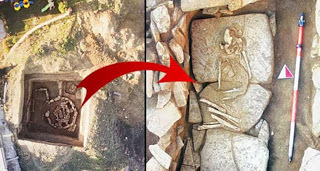
The intact tomb of a Thracian warrior dating back some 5,000 years has been excavated in Turkey, the Istanbul Archaeology Museum announced. Experts are calling it the biggest archaeological find so far this year in Turkey—a country with many important archaeological sites.
The kurgan tumulus is the first intact burial chamber of its kind ever found, says an article about the news in DailySabah.com. The dig on the kurgan started in December 2015 in Silivri in the Çanta region.
Hurriyet Daily News says the tumulus was looted. However, looters had tried but failed to dig into the main burial chamber.
The tumulus was likely that of a prominent Bronze Age warrior from northern areas. Researchers assume he was a warrior because they found a spear point in his grave, according to the First Istanbul Board for the Protection of Cultural Artifacts.
Hurriyet Daily News says a kurgan is a burial mound constructed in a circle over a grave in a pit. Kurgan burials often have grave vessels, weapons and one body. “The type of tomb was originally used on the Russian steppes but later spread to eastern, central and northern Europe in the 3rd millennium B.C. The type of grave was holy in Turkic and Altay culture,” the article states.
The Royal Kurgan of Kerch: The burial mound built by a kingSecret Chamber Found at Scythian Burial Mound Reveals Golden Treasure of Drug-Fueled Rituals4,000-Year-Old Chariots Discovered in Burial Chamber of Bronze Age ChiefProfessor Mehmet Özdoğan of Istanbul University Department of Archeology told Daily Sabah he has studied such tumuli before, but this discovery is important because it is the oldest one found in Thrace. It’s hoped the tomb will help shed light on historical mysteries about Thrace and help with studies about ancient Istanbul.
Years ago, Özdoğan excavated another Thracian kurgan, from around 1200 BC in the village of Asılbeyli in Kırklareli in eastern Thrace, Daily Sabah says.
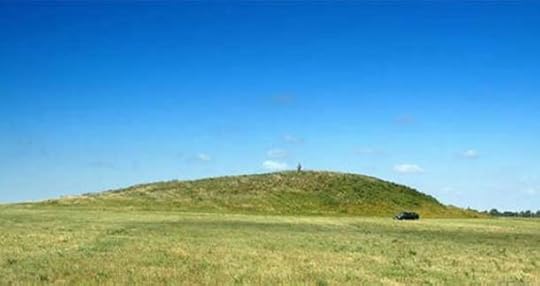 Sarmatian Kurgan 4th c. BC, Fillipovka, S.Urals. Source: Wikipedia The Istanbul Archaeology Museum wants to register the grave as a historical site and place the remains of the warrior on exhibit in the museum.
Sarmatian Kurgan 4th c. BC, Fillipovka, S.Urals. Source: Wikipedia The Istanbul Archaeology Museum wants to register the grave as a historical site and place the remains of the warrior on exhibit in the museum.
Kurgans are considered sacred burials in Turkic and Altaic cultures. People were buried in kurgans widely across central Asia and Eastern Europe. The word kurgan is from an unknown Turkic language and in Turkish means “fortress,” says Daily Sabah.
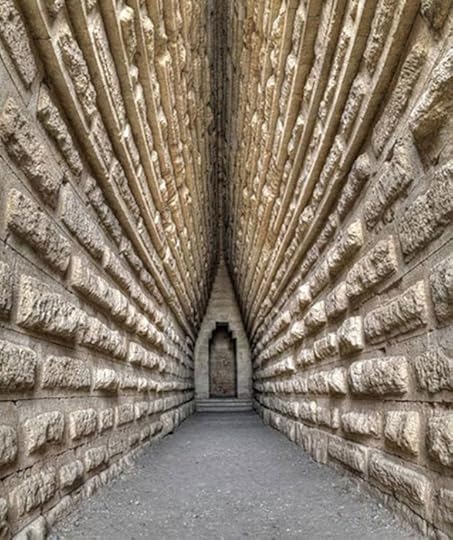 Interior of the Tsarsky Kurgan, Crimean Peninsula, 4th century B.C. (Wikimedia Commons)The practice of building kurgans for important people’s burials was done from the Copper Age, through the Bronze, Iron ages and into the Middle Ages, though it was not as popular during later times.
Interior of the Tsarsky Kurgan, Crimean Peninsula, 4th century B.C. (Wikimedia Commons)The practice of building kurgans for important people’s burials was done from the Copper Age, through the Bronze, Iron ages and into the Middle Ages, though it was not as popular during later times.
One of the most prominent historical figures buried in a kurgan was Philip II of Macedon—father of Alexander of Macedon. Philip was buried in Greece.
The circular tomb chamber is 6 meters (19.7 feet) across and is inlaid with stones. The actual tomb itself is rectangular. The skeleton was on a stony floor in the fetal position, and his arms were placed to embrace his legs. Researchers say this may be either so he could enter the next world like a newborn or as a way to prevent him from rising from the dead.
In addition to the spear point, which was on the body, archaeologists found two Bronze Age earthenware pots. Hurriyet called the point an arrowhead and added that it helped identify him as an important soldier or even a commander.
There is a detailed study here about the Kurgan culture, which was widespread from Europe to Kazakhstan and up into Russia. The site says the Kurgan culture differs had common elements, including the distinctive burials, that differentiate it from other Bronze Age cultures in the regions where they overlapped.
Top image: Newly discovered kurgan burial in Turkey ( Daily Sabah )
By Mark Miller

The intact tomb of a Thracian warrior dating back some 5,000 years has been excavated in Turkey, the Istanbul Archaeology Museum announced. Experts are calling it the biggest archaeological find so far this year in Turkey—a country with many important archaeological sites.
The kurgan tumulus is the first intact burial chamber of its kind ever found, says an article about the news in DailySabah.com. The dig on the kurgan started in December 2015 in Silivri in the Çanta region.
Hurriyet Daily News says the tumulus was looted. However, looters had tried but failed to dig into the main burial chamber.
The tumulus was likely that of a prominent Bronze Age warrior from northern areas. Researchers assume he was a warrior because they found a spear point in his grave, according to the First Istanbul Board for the Protection of Cultural Artifacts.
Hurriyet Daily News says a kurgan is a burial mound constructed in a circle over a grave in a pit. Kurgan burials often have grave vessels, weapons and one body. “The type of tomb was originally used on the Russian steppes but later spread to eastern, central and northern Europe in the 3rd millennium B.C. The type of grave was holy in Turkic and Altay culture,” the article states.
The Royal Kurgan of Kerch: The burial mound built by a kingSecret Chamber Found at Scythian Burial Mound Reveals Golden Treasure of Drug-Fueled Rituals4,000-Year-Old Chariots Discovered in Burial Chamber of Bronze Age ChiefProfessor Mehmet Özdoğan of Istanbul University Department of Archeology told Daily Sabah he has studied such tumuli before, but this discovery is important because it is the oldest one found in Thrace. It’s hoped the tomb will help shed light on historical mysteries about Thrace and help with studies about ancient Istanbul.
Years ago, Özdoğan excavated another Thracian kurgan, from around 1200 BC in the village of Asılbeyli in Kırklareli in eastern Thrace, Daily Sabah says.
“Thrace received migrations from the north. This is a kurgan-style tomb and such tombs exist in my studies, too,” Özdoğan told Hurriyet Daily News. “I know that lots of kurgan tombs have been destroyed in Thrace. We have rescued one of them from the digger. But this tomb is older and is from the Bronze Age. It is a very important discovery. I believe scientific examinations will lead to interesting results.”
 Sarmatian Kurgan 4th c. BC, Fillipovka, S.Urals. Source: Wikipedia The Istanbul Archaeology Museum wants to register the grave as a historical site and place the remains of the warrior on exhibit in the museum.
Sarmatian Kurgan 4th c. BC, Fillipovka, S.Urals. Source: Wikipedia The Istanbul Archaeology Museum wants to register the grave as a historical site and place the remains of the warrior on exhibit in the museum.Kurgans are considered sacred burials in Turkic and Altaic cultures. People were buried in kurgans widely across central Asia and Eastern Europe. The word kurgan is from an unknown Turkic language and in Turkish means “fortress,” says Daily Sabah.
 Interior of the Tsarsky Kurgan, Crimean Peninsula, 4th century B.C. (Wikimedia Commons)The practice of building kurgans for important people’s burials was done from the Copper Age, through the Bronze, Iron ages and into the Middle Ages, though it was not as popular during later times.
Interior of the Tsarsky Kurgan, Crimean Peninsula, 4th century B.C. (Wikimedia Commons)The practice of building kurgans for important people’s burials was done from the Copper Age, through the Bronze, Iron ages and into the Middle Ages, though it was not as popular during later times.One of the most prominent historical figures buried in a kurgan was Philip II of Macedon—father of Alexander of Macedon. Philip was buried in Greece.
The circular tomb chamber is 6 meters (19.7 feet) across and is inlaid with stones. The actual tomb itself is rectangular. The skeleton was on a stony floor in the fetal position, and his arms were placed to embrace his legs. Researchers say this may be either so he could enter the next world like a newborn or as a way to prevent him from rising from the dead.
In addition to the spear point, which was on the body, archaeologists found two Bronze Age earthenware pots. Hurriyet called the point an arrowhead and added that it helped identify him as an important soldier or even a commander.
There is a detailed study here about the Kurgan culture, which was widespread from Europe to Kazakhstan and up into Russia. The site says the Kurgan culture differs had common elements, including the distinctive burials, that differentiate it from other Bronze Age cultures in the regions where they overlapped.
Top image: Newly discovered kurgan burial in Turkey ( Daily Sabah )
By Mark Miller
Published on May 18, 2016 05:12




